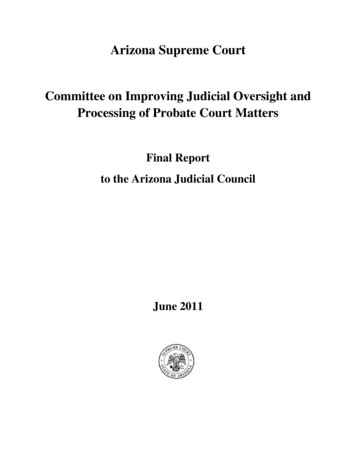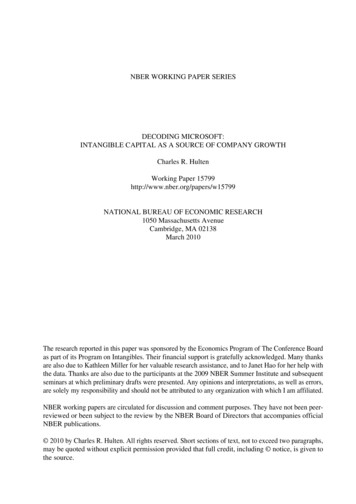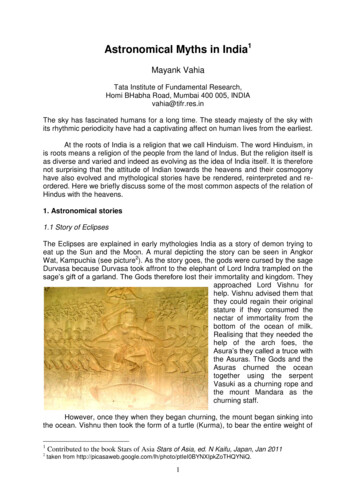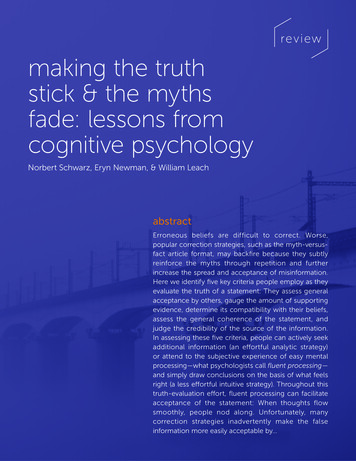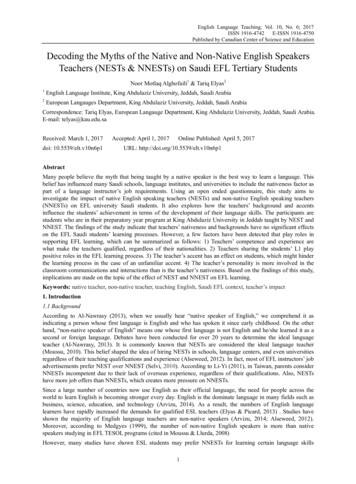
Transcription
English Language Teaching; Vol. 10, No. 6; 2017ISSN 1916-4742E-ISSN 1916-4750Published by Canadian Center of Science and EducationDecoding the Myths of the Native and Non-Native English SpeakersTeachers (NESTs & NNESTs) on Saudi EFL Tertiary StudentsNoor Motlaq Alghofaili1 & Tariq Elyas21English Language Institute, King Abdulaziz University, Jeddah, Saudi Arabia2European Langauges Department, King Abdulaziz University, Jeddah, Saudi ArabiaCorrespondence: Tariq Elyas, European Langauge Department, King Abdulaziz University, Jeddah, Saudi Arabia.E-mail: telyas@kau.edu.saReceived: March 1, 2017doi: 10.5539/elt.v10n6p1Accepted: April 1, 2017Online Published: April 5, 2017URL: http://doi.org/10.5539/elt.v10n6p1AbstractMany people believe the myth that being taught by a native speaker is the best way to learn a language. Thisbelief has influenced many Saudi schools, language institutes, and universities to include the nativeness factor aspart of a language instructor’s job requirements. Using an open ended questionnaire, this study aims toinvestigate the impact of native English speaking teachers (NESTs) and non-native English speaking teachers(NNESTs) on EFL university Saudi students. It also explores how the teachers’ background and accentsinfluence the students’ achievement in terms of the development of their language skills. The participants arestudents who are in their preparatory year program at King Abdulaziz University in Jeddah taught by NEST andNNEST. The findings of the study indicate that teachers’ nativeness and backgrounds have no significant effectson the EFL Saudi students’ learning processes. However, a few factors have been detected that play roles insupporting EFL learning, which can be summarized as follows: 1) Teachers’ competence and experience arewhat make the teachers qualified, regardless of their nationalities. 2) Teachers sharing the students’ L1 playpositive roles in the EFL learning process. 3) The teacher’s accent has an effect on students, which might hinderthe learning process in the case of an unfamiliar accent. 4) The teacher’s personality is more involved in theclassroom communications and interactions than is the teacher’s nativeness. Based on the findings of this study,implications are made on the topic of the effect of NEST and NNEST on EFL learning.Keywords: native teacher, non-native teacher, teaching English, Saudi EFL context, teacher’s impact1. Introduction1.1 BackgroundAccording to Al-Nawrasy (2013), when we usually hear “native speaker of English,” we comprehend it asindicating a person whose first language is English and who has spoken it since early childhood. On the otherhand, “non-native speaker of English” means one whose first language is not English and he/she learned it as asecond or foreign language. Debates have been conducted for over 20 years to determine the ideal languageteacher (Al-Nawrasy, 2013). It is commonly known that NESTs are considered the ideal language teacher(Moussu, 2010). This belief shaped the idea of hiring NESTs in schools, language centers, and even universitiesregardless of their teaching qualifications and experience (Alseweed, 2012). In fact, most of EFL instructors’ jobadvertisements prefer NEST over NNEST (Selvi, 2010). According to Li-Yi (2011), in Taiwan, parents considerNNESTs incompetent due to their lack of overseas experience, regardless of their qualifications. Also, NESTshave more job offers than NNESTs, which creates more pressure on NNESTs.Since a large number of countries now use English as their official language, the need for people across theworld to learn English is becoming stronger every day. English is the dominate language in many fields such asbusiness, science, education, and technology (Arvizu, 2014). As a result, the numbers of English languagelearners have rapidly increased the demands for qualified ESL teachers (Elyas & Picard, 2013) . Studies haveshown the majority of English language teachers are non-native speakers (Arvizu, 2014; Alseweed, 2012).Moreover, according to Medgyes (1999), the number of non-native English speakers is more than nativespeakers studying in EFL TESOL programs (cited in Moussu & Llurda, 2008)However, many studies have shown ESL students may prefer NNESTs for learning certain language skills1
elt.ccsenet.orgEnglish Language TeachingVol. 10, No. 6; 2017(Alseweed, 2012; Ma & Ping, 2012; Walkinshaw & Oanh, 2014). In addition, according to Beckett andStiefvater (2009), students enjoy learning from NNESTs in courses like presentation skills, mathematics,engineering, and business, especially from NNESTs who share their cultural background.1.2 Significance of the StudyMost studies have been done within the context that English is used as a native language, like in the UnitedStates. In fact, few studies have been conducted in Arabian contexts (Al-Nawrasy, 2013). Since learning Englishlanguage has become essential for university students as part of their higher education requirements, theirpreferences towards NESTs became stronger to fit their ideal way to acquire the English language throughlearning how to use it in communication (Alseweed & Daif-Allah, 2012).Since most of the studies were conducted according to teachers and students perceptions towards NEST andNNEST, very few studies have been conducted on the impact of NEST and NNEST on students in the Saudicontext. Moreover, those studies conducted in the Saudi context included only male teachers’ and the students’voice (Al-Omrani, 2008). Also, such Arabian studies are urgently needed, especially in Saudi Arabia where theeducation movement is rapidly increasing the demands for English courses to be a part of the university students’qualifications (Mahboob & Elyas, 2014; Elyas & Picard, 2013). This study can be very important for manyreasons. First, it can draw a clear picture for the students, educators, and administrators about the ideal languageinstructor, regardless of nativeness. Second, it might help change the idea in Saudi Arabia “that foreign languageshould be taught by a native speaker of the language” (Alseweed, 2012) and give more job opportunities toteachers based on qualifications. Finally, it will help the administrators and decision makers in assigning the besttasks for NESTs and NNESTs, placing them where they can achieve higher goals.1.3 Purpose and Aim of the StudyThis study will investigate the impact of native English speaking teachers (NESTs) and non-native Englishspeaking teachers (NNESTs) on EFL university Saudi students. It will also explore how the teachers’ backgroundand accents influence the students’ achievements in terms of the development of their language skills.Additionally, this study will clarify if teachers’ nativeness has a significant effect on factors that are essential tothe learning process such as: assessments, classroom interaction and classroom management.2. Literature Review2.1 Native vs. Non-Native General PerceptionsAccording to Phillipson (1996), contrary to popular belief, the fact that non-native English speaking teachers(NNESTs) have acquired the language as an additional language makes them ideal ESL teachers (as cited inAlseweed, 2012). A study conducted by Beckett and Stiefvater (2009), in which 15 students were observed andinterviewed, stated that students enjoyed being taught by NNESTs, especially ones who shared their culturalbackground and were more aware of their needs. According to a study in Hong Kong by Ma and Ping (2012), theinterviews show that NNESTs can be more sensitive to students’ learning problems and better anticipate theirlearning difficulties. Furthermore, survey questionnaires have indicated that NNESTs are good learner models,are more informative about the language, can use effective teaching strategies, and can predict learners’ languagedifficulties (Moussu, 2010). NNESTs were described as enthusiastic, knowledgeable, informative, and consciousof students’ needs (Alseweed & Daif-Allah, 2012). Additionally, Pereira’s (2009) triangulation techniques(questionnaire, interviews, and classroom observation) have affirmed that Arab students show positive attitudestowards ESL teachers who share their background and native language.In contrast, according to Hertel and Sunderman’s (2009) survey results, native English speaking teachers (NESTs)are more knowledgeable, and their teaching potential is much higher than that of NNESTs, which leads to anincrease in the learning potential of students taught by NESTs. In addition, students are comfortable in theirclasses with NESTs, who are friendly and lenient, making the learning environment relaxing and less threatening(Alseweed, 2012). In addition, being taught by NESTs can be motivating to students who enjoy learning aboutother cultures (Walkinshaw & Oanh, 2014).However, teachers’ effectiveness in motivating students and in giving them the chance to develop their skills ismore important than the teachers’ nativeness (de Dios Martínez Agudo & Robinson, 2014). Using linguisticanalysis of students’ text, Lipovsky and Mahboob (2010) found that students do not really prefer NESTs orNNESTs, but they value the cooperation of NESTs and NNESTs in their English learning. A study conductedusing a survey questionnaire in Vietnam by Walkinshaw and Oanh (2012) showed that there are factors moreimportant than the teachers’ nativeness, such as teaching experience, friendly personality, qualifications,students’ cultural familiarity, and teaching styles. Many studies have also reported that a learner’s experience,2
elt.ccsenet.orgEnglish Language TeachingVol. 10, No. 6; 2017background, gender, and taste might influence their perceptions towards their teachers (Beckett & Stiefvater,2009).2.2 Native vs. Non-Natives in Terms of Skills and Teaching AbilitiesMany studies have reported similar findings regarding which teacher is considered the best in teaching certainskills. The literature indicates that NESTs are better at teaching skills, especially communicative skills(Al-Nawrasy, 2013). Alseweed and Daif-Allah (2012) found that NNESTs are considered better teachers ofgrammar and writing due to their knowledge of rules and structure, whereas NESTs are superior in teachinglistening, speaking, and reading. According to Mahboob (2004), NNESTs are better at teaching reading, writing,grammar, and language-learning skills due to their cultural awareness and metalinguistic nature. Also, NESTslack the competence that NNESTs have in explaining complex grammar and lexical rules (Walkinshaw & Oanh,2014). Beckett and Stiefvater (2009) also reported that students showed positive attitudes towards NNESTsteaching courses such as presentation skills, business, and mathematics. However, NESTs are found to be morefocused on grammatical form and fast speech, whereas NNESTs are more concerned with the content and withencouraging students’ self-expression (Kim, 2009). Kim (2009) also indicates that NNESTs provide lessfeedback to the students on specific grammatical areas. Whereas, NESTs sometimes depend on their grammaticalintuition in teaching grammar, which cannot be relied on in all cases (Ma & Ping, 2012).2.3 Native vs. Non-Natives in Terms of Accents and FluencyButler (2007) reports that accent might very well influence students’ attitudes towards their teachers. NESTs useof informal language in classrooms enhances students’ learning and motivates them to learn the language(Alseweed & Daif-Allah, 2012). Acceptance of foreign accents may vary according to Buckingham (2014), butaccents are not very popular among students, especially accents that display regional variations. NESTs usuallyemphasize language fluency rather than accuracy, which explains their use of interactive activities that developstudents’ communicative competence (Alseweed & Daif-Allah, 2012). Furthermore, students might lackmotivation in speaking English with their NNESTs (Ma & Ping, 2012). Finally, Mahmud and Ching (2012)stated that the more comprehensible the teacher’s language, the more preferred the teacher is by students.2.4 Native vs. Non-Natives in Terms of Assessments and Evaluations:NESTs are found to be more lenient towards mistakes and more flexible in evaluating the students’ progress(Alseweed, 2012; Alseweed & Daif-Allah, 2012). According to Kim (2009), there is no significant difference inthe way NESTs and NNESTs assist their students in oral performance. However, he found that NESTs providedetailed and elaborate comments when evaluating students, whereas NNESTs give general comments to theirstudents regarding their performance. Moreover, Al-Nawrasy (2013) revealed that the difference betweenstudents who have been taught by NESTs and those taught by NNESTs can barely be perceived in their speakingexams.2.5 Native vs. Non-Natives in Arabian ContextVery few studies have been conducted on NESTs and NNESTs in the Arabian context. A study was conductedon Saudi university’s students using questionnaires, interviews, and classroom visits. This study reported thatNNESTs were described as enthusiastic, knowledgeable, informative, and conscious of students’ needs(Alseweed & Daif-Allah, 2012). Using surveys and interviews on 169 EFL university students, Alseweed (2012)showed that higher-level students prefer NESTs in general and in terms of using different teaching strategies.However, students have reported positive feedback regarding NNESTs in terms of acknowledging their needsand providing a serious learning environment. In another study, similar techniques of questionnaire andinterviews were used on 100 Saudi EFL/ESL students, revealing that teachers’ qualifications and skills arehighly appreciated without much attention being paid to teachers’ backgrounds (Al-Omrani, 2008). In addition,results have also shown that a combination of the qualities of NESTs and NNESTs may lead to more effectiveEFL teaching programs. In a study by Buckingham (2014), 347 Omani students were asked to evaluate fivespeakers who we
and accents influence the students’ achievements in terms of the development of their language skills. Additionally, this study will clarify if teachers’ nativeness has a significant effect on factors that are essential to the learning process such as: assessments, classroom interaction and classroom management. 2. Literature Review
